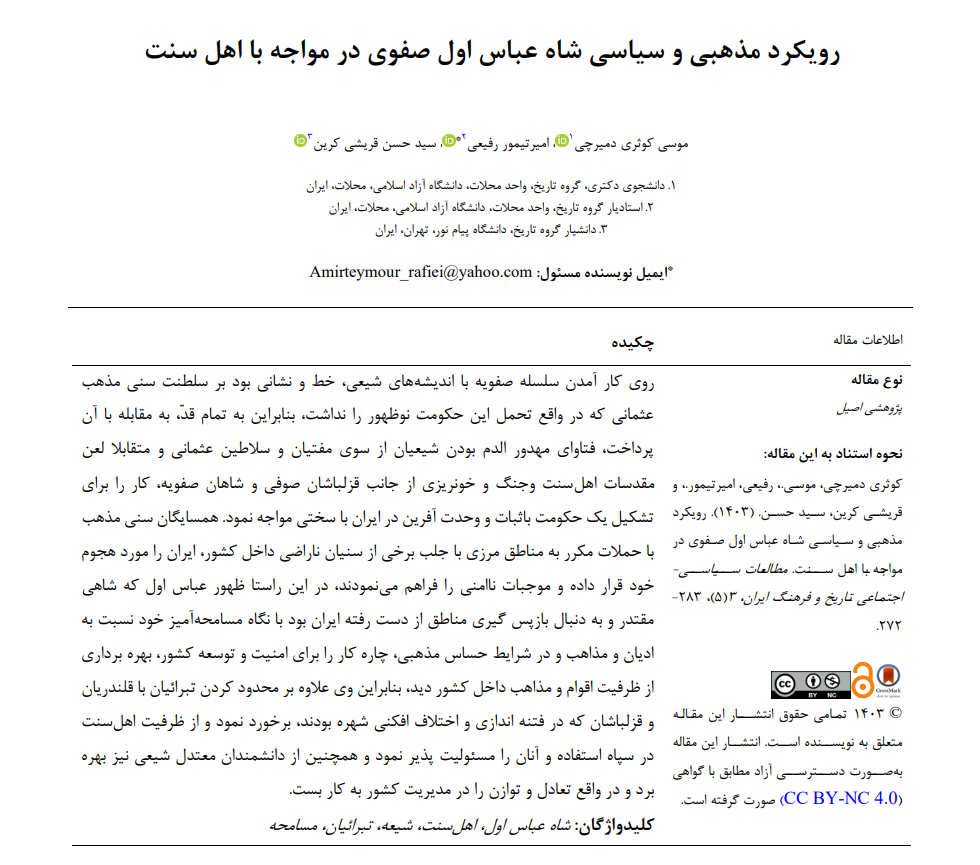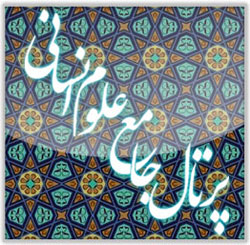The Religious and Political Approach of Shah Abbas I Safavid in Dealing with Sunnis
Keywords:
Shah Abbas I, Sunnis, Shiites, Tabaraites, MusamahAbstract
The rise of the Safavid dynasty, founded on Shiite ideology, posed a direct challenge to the Sunni Ottoman Empire, which found the presence of this emerging power intolerable. Consequently, the Ottomans launched full-scale opposition against it. The issuance of fatwas declaring Shiites as deserving of death by Ottoman jurists and sultans, in response to the cursing of Sunni sanctities and the ensuing violence by Qizilbash Sufis and Safavid kings, significantly hindered the establishment of a stable and unifying government in Iran. Sunni neighbors, through repeated attacks on border regions and by enlisting discontented Sunnis within the country, frequently invaded Iran and contributed to internal instability. In this context, the emergence of Abbas I—a powerful monarch intent on reclaiming lost Iranian territories—marked a pivotal turn. With a policy of religious tolerance amid sensitive sectarian circumstances, he sought to utilize the potential of various ethnic and religious groups within the country to ensure national security and development. To this end, he not only curtailed the influence of Tabarra’iyan alongside the Qalandariyya and Qizilbash, who were notorious for incitement and sectarian discord, but also incorporated Sunnis into the military and assigned them official responsibilities. Furthermore, he drew upon the expertise of moderate Shiite scholars, thus employing a strategy of balance and moderation in national governance.
Downloads
References
Afandi, A. b. I. B. (2010). Riyadh al-Ulema wa Hiyadh al-Fozala (Gardens of Scholars and Pools of the Virtuous) (Translated by M. Bagher Saedi Khorasani ed., Vol. 3). Mashhad: Astan Quds Razavi, Islamic Research Foundation.
Ajan, Y., & Espenaghchi Pashazadeh, M. A. b. M. S. (2001). History of Iran, Safavid Period The Islamic Revolution Between the Elite and the Common People (Translated from the Cambridge University Press Compiled by R. Jafarian ed.). Tehran: Jami Qom: Dalil Publications.
Bartold, V. V. (1996). The Place of the Areas Around the Caspian Sea in the History of the Islamic World (Translated by L. Raban Shah ed.). Tehran: Institute for Humanities and Cultural Studies.
Della Valle, P. (2005). The Travels of Pietro Della Valle (Translated by Shoja' al-Din Shafa ed.). Tehran: Sherkat-e Entesharat-e Elmi va Farhangi.
Eskandar Beyg Monshi, T. (2003). Tarikh-e Alam Aray-e Abbasi (History of the World-Adorning Abbasid)VL - 1, 2, & 3 (Edited and with an introduction by I. Afshar ed.). Tehran: Amir Kabir.
Etemad al-Saltaneh, M. H. b. A. (1988). Mirat al-Buldan (Mirror of the Lands) (Edited by H. Mohaddeth & A. Hossein Navai ed., Vol. 4). Tehran: University of Tehran.
Falsafi, N. (1974). Zendegani-ye Shah Abbas-e Awal (The Life of Shah Abbas I) (Vol. 3). Tehran: University of Tehran.
Falsafi, N. (1992). Zendegani-ye Shah Abbas-e Awal (The Life of Shah Abbas I) (Vol. 1 & 2). Tehran: Elmi Publications.
Ghadiani, A. (2008). Farhang-e Jame-ye Tarikh-e Iran (Comprehensive History of Iran) (Introduction by G. Reza Vatan Dust ed., Vol. 2). Tehran: Aron.
Grantovsky. (1980). Tarikh-e Iran az Zaman-e Bastan ta Emruz (History of Iran from Ancient Times to the Present) (Translated by K. Keshavarzi ed.). Tehran: Pouyesh.
Jafarian, R. (2000). The Safavids in the Field of Religion, Culture and Politics (Vol. 1 & 2). Qom: Research Institute of Hawza and University.
Jafarian, R. (2008). History of Shi'ism in Iran. Tehran: Nashr-e Elm.
Lockhart, L. (2004). The Fall of the Safavid Dynasty (Translated by E. Dolatshahi ed.). Tehran: Sherkat-e Entesharat-e Elmi va Farhangi.
Mahdavi, M. (2007). A'lam-e Esfahan (Celebrities of Isfahan) (Edited by G. Reza Nasrallahi Introduction by M. A. Chalongar ed., Vol. 4). Isfahan: Isfahan Municipality, Cultural and Recreational Organization.
Mir Mohammad Sadegh, S. S. (2003). Sar Gozasht-e Shah Abbas-e Awal (The Story of Shah Abbas I) (Vol. 1). Tehran: Ahl-e Ghalam Publications.
Monajem, M. J. (1987). Tarikh-e Abbasi ya Ruznameh-ye Mola Jalal (History of Abbasi or Journal of Mullah Jalal) (Edited by S. Vahidnia ed.). Tehran: Vahid PublicationsER -.
Monshi Qomi, A. b. H. (2004). Khulasat al-Tawarikh (Summary of Histories) (Edited by E. Eshraghi ed., Vol. 1). Tehran: University of Tehran, Institute of Publications and Printing.
Olivier, G. A. (1992). Voyage d'Olivier (Olivier's Travels) (Translated by M. Taher Ghajar ed.). Tehran: Ettela'at.
Raben, K. M. (1970). The System of Provinces in the Safavid Period (Translated by K. Jahandari ed.). Tehran: Sherkat-e Entesharat-e Elmi va Farhangi.
Rabino, H. L. (1995). Velayat-e Dar al-Marz of Iran (Translated by Jafar Khamami Zadeh ed.). Rasht: Ta'ati Publications.
Ravandi, M. (1975). Tarikh-e Ejtema'i-ye Iran (Social History of Iran) (Vol. 2, 3, 4, & 8). Tehran: Amir Kabir.
Savory, R. (2005). Iran Under the Safavids (Translated by K. AziziPB - Tehran: Nashr-e Markaz ed.).
Sefatgol, M. (2010). The Structure of Religious Institutions and Thought in Safavid Iran. Tehran: Rasa.
Shirley, A. (2008). The Travels of the Shirley Brothers (Translated by H. Massiyan Compiled by A. Dehbashi ed.). Tehran: Negah Publications.
Tajbakhsh, A. (1999). History of the Safavids. Shiraz: Navid Shiraz.
Zaki Beyg, M. A., & Sanandaji, S. b. A. (2002). Zobdat al-Tarikh-e Kurd va Kurdistan (The Essence of the History of Kurds and Kurdistan) Tohfeh-ye Naseri dar Tarikh va Joghrafia-ye Kurdistan (Naseri's Gift on the History and Geography of Kurdistan) (Translated by Y. Roshan Ardalan Edited by H. Tabibi ed., Vol. 1 & 2). Tehran: Toos Tehran: Amir Kabir.








